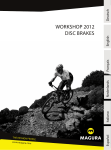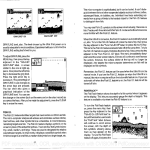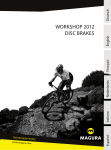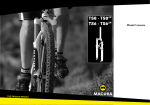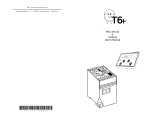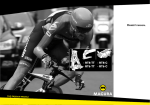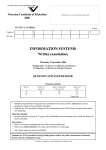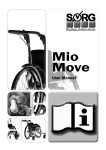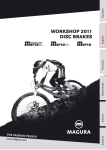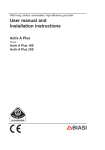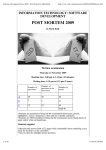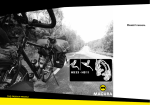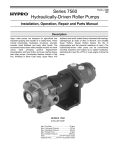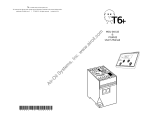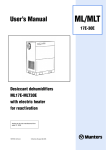Download Workshop disc Brakes
Transcript
English Deutsch The passion pe www.magura.co ople m Español Italiano Nederlands Français Workshop Disc Brakes DE: Zulässiges Gesamtgewicht für die Bremsscheiben Storm und Storm SL: EN: Permissible total weight for Storm and Storm SL rotors: FR: Poids total admissible pour les disques de frein Storm et Storm SL : NL: Toelaatbaar totaalgewicht voor de remschijven Storm en Storm SL: IT: Peso totale consentito per i dischi Storm e Storm SL: ES: Peso total permitido para los discos Storm y Storm SL: Storm SL Storm 160/140 160/160 180/160 180/180 203/180 203/203 90kg - XC-Race 100kg 120kg 140kg 150kg 160kg - 110kg 130kg 150kg 180kg 200kg Ausstattungsänderungen und Irrtümer vorbehalten. 1 Deutsch English Français Nederlands Italiano 1. Welcome.......................................................................................................................2 2. Notes about this manual.............................................................................................4 3. Appropriate use...........................................................................................................7 4. Before the first ride.....................................................................................................9 5. Before every ride....................................................................................................... 11 6. After a fall...................................................................................................................14 7. Braking correctly.......................................................................................................16 7.1 Adjusting the brake levers – ergonomics...............................................................16 7.2 Optimum (full) braking – weight shift.....................................................................17 7.3 Prolonged braking.................................................................................................18 7.4 Braking before / in corners....................................................................................18 8. Transport of the bicycle............................................................................................19 9. Installing the brake....................................................................................................20 9.1 Installing the brake levers on the handlebars........................................................21 9.2 Installing the rotor on the wheel.............................................................................22 9.3 Installing the brake calliper on the frame or the fork..............................................23 9.4 Aligning the brake hose.........................................................................................25 10. Shortening the brake hose.....................................................................................26 10.1 Special points about hoses routed in the frame..................................................30 11. Maintenance.............................................................................................................31 11.1 Table for maintenance work.................................................................................31 11.2 Checking and replacing the brake pads...............................................................32 11.2.1 Checking the brake pads.................................................................................32 11.2.2 Replacing the brake pads................................................................................33 11.3 Checking and replacing the rotor.........................................................................35 11.3.1 Checking the rotor...........................................................................................35 11.3.2 Replacing the rotor..........................................................................................35 11.4 Cleaning the brake...............................................................................................36 12. Repair work..............................................................................................................36 13. Bleeding / Filling the brake system.......................................................................37 13.1 Filling and bleeding the brake with the MAGURA Service Kit.............................38 14. Tips...........................................................................................................................43 14.1 Help in dealing with squealing brakes? ..............................................................43 14.2 Brake pads rub – slave pistons extend unevenly................................................43 14.3 Lightweight quick-release skewers?....................................................................44 15. Troubleshooting......................................................................................................45 16. Accessories and tools............................................................................................46 16.1 Adaptor................................................................................................................46 16.2 Further MAGURA accessories and tools . ..........................................................49 17. Guarantee and warranty.........................................................................................50 Español Contents 1. WelCoMe Congratulations! You have chosen a fully hydraulic disc brake from MAGURA. You will be amazed by its awesome braking power and the minimum amount of maintenance that is required. Millions of riders around the world rely on the stoppers from the Swabian pioneer of hydraulic brakes. We paid attention to perfected ergonomics as well as to their functionality in the disc brakes of the very latest MAGURA MT model series. The force applied by your hand to produce the movement of the brake level is transferred by a piston in the brake lever mount through a column of mineral oil. The column of mineral oil is moved towards the brake callipers by the movement of the lever. This results in the brake pads being pressed from both sides against the rotor. The friction between the pads and the rotor slows the bicycle, which also produces heat. The rotor and callipers become hot! Never touch either the rotor or the brake callipers after long downhill runs or prolonged braking as there is a risk of burns! You will be delighted to discover that disc brakes of the MAGURA MT model series have an enormous braking effect even with little hand force being applied while at the same time being less susceptible to the weather conditions. In wet conditions in particular disc brakes respond noticeably quicker than rim brakes and have the expected strong action after just a short time. The system does not wear the wheel rims, but under certain circumstances, for example, if they have not been installed optimally they can cause squealing noises, mainly in wet weather conditions. Please note that there are different versions of the MAGURA MT model series for various types of installations and disc diameters. Installation is done with various adaptors, but the basic installation steps are always the same. 2 In the MAGURA Forum at magura.com you can get free online help from power users at any time. Stay tuned with the Passion People! 3 Deutsch Español Italiano Nederlands Thank you for your confidence in our products, enjoy your ride and your new MAGURA disc brake! English If you still have any questions or if any problems occur, then we recommend that you visit our homepage www. magura.com where you can always find up to date information and the hottest tips regarding our products. From there you can also download this manual as a PDF file in A4 format. Français This manual is a constituent part of the product. Do not pass on the brake to a new owner without also passing on this manual. We explicitly reserve the right to make technical changes and improvements. 2. Notes about this manual In this manual we have put together for you many tips on how to use your disc brake and also a great deal of useful knowledge concerning bicycles in general and their maintenance and care. Please read this manually thoroughly and to the end. It is worth doing so, even if you having been riding bicycles all your life. Brake technology in particular has moved forward hugely in recent years. Before you ride off for the first time with your new MAGURA disc brake, you should have read at least the two sections “Appropriate use” and “Before the first ride.” Before you get onto your bicycle, you should always carry out the function check described in the section “Before EVERY ride” so that you will have fun when riding. Even a manual that is as thick as an encyclopaedia cannot possibly cover every single combination of bicycle and components that can be found on the market. For that reason this manual concentrates on your newly purchased MAGURA fully hydraulic disc brake and the most common components and gives the main information and warnings. When you carry out the maintenance and servicing work that is described in detail, you should always bear in mind that the instructions and information only apply to MAGURA fully hydraulic disc brakes. Note that this manual may need to be supplemented, depending on the experience and/or skill of the person doing the work. Some kinds of work can require an additional (special) tool or additional instructions. This manual simply cannot convey to you all the skills of an experienced bicycle mechanic. Before you set off, here are a few points that concern us very much as cyclists: Never set off without a suitable helmet and glasses, and ensure that you are wearing suitable high-visibility clothing for cycling, but at the very least with close-fitting clothing for your legs plus shoes that are suitable for the pedal system on your bicycle. Always ride with care in road traffic and follow the traffic regulations so that you are not a danger to yourself or to other people. 4 As with any other kind of sport, you can also injure yourself when cycling. When you get onto a bicycle you must be aware of this danger and accept it. Always bear in mind that when you are on a bicycle you do not have the safety facilities of a car such as the ABS anti-blocking system or an airbag – or a sheet steel car body. For that reason take suitable care at all times and respect other road users. Deutsch English This book cannot teach you how to ride a bicycle. When you ride a bicycle, you need to be aware that it is a potentially hazardous activity and that the rider must have his or her bicycle under control at all times. Nederlands Comply with the relevant regulations for the use of bicycles off the road. These regulations differ in each country. Please treat nature with respect if you are touring through the woods and fields. Only cycle on marked and paved paths and roads. We would first of all like to explain to you the components of your new MAGURA fully hydraulic disc brake. Unfold the folded front page of this instruction manual. This illustrates in graphic form the brake lever and mount, brake calliper and numerous small parts, which are also described there. Leave this page folded out during reading. This helps you to quickly find that parts that are being referred to in the text. Français Never go cycling when under the influence of medications, drugs or alcohol or if you are tyred. Never allow a second person to ride on your bicycle and always keep both hands on the handlebars. 5 Español Italiano For your own safety, do not attempt too much. If you are not absolutely certain or if you still have any questions, then please contact your MAGURA dealer. note the following symbols on particular: This symbol indicates a possible danger to life and limb if you do not follow certain requirements for action or if you do not take the appropriate safety measures. This symbol warns you about errors or mistakes that could either cause harm to the environment or other forms of damage. This symbol gives information on how to handle the product or else points out the relevant part of these instructions that requires special attention. The possible consequences are not always described again when these symbols are shown. This is not a set of instructions to allow you to build a bicycle out of individual components, to repair one or to put a partially assembled bicycle into working order. This manual is not applicable for anything other than the fully hydraulic disc brake of the MAGURA MT model series that is shown here. We reserve the right to make changes to the technical details with regard to the specifications and illustrations in this instruction manual. This manual is subject to European legislation. If a MAGURA fully hydraulic disc brake is supplied outside Europe then additional instructions must be provided by the bicycle manufacturer. 6 The disc brakes of the MAGURA MT model series are suitable for use on various types of bicycle and have been approved accordingly. In addition to the various categories of mountain bikes this applies in particular to trekking and city bikes. Deutsch 3. APPRoPRIAte use Storm SL ◄ Rotors with a diameter of 160 mm (front and rear) may only be used if the total weight of the rider, luggage and bicycle together is not exceeded. Exact details on the total weight are given in the table on page 8. Storm 160 Storm SL ◄ Rotors with a diameter of 180 mm (front and rear) may only be used if the total weight of the rider, luggage and bicycle together is not exceeded. Exact details on the total weight are given in the table on page 8. Storm 180 Français 140 160 Nederlands ◄ Rotors with a diameter of 160 mm (front) and 140 mm (rear) may only be used in the XC race area by experienced riders if the total weight of the rider, luggage and bicycle together is not exceeded. Exact details on the total weight are given in the table on page 8. Storm English The braking action can be impaired if you do not comply with the following instructions. This can lead to a total failure of the brake. Risk of accidents! 203 Storm SL 7 ◄ Rotors with a diameter of 203 mm (front and rear) may only be used if the total weight of the rider, luggage and bicycle together is not exceeded. Exact details on the total weight are given in the table on page 8. Español Storm Italiano Storm SL Tips for the selection of the correct rotor diameter and the rotor version: ◄ MAGURA recommends in principle that the front and rear rotors are of the same diameter. The majority of the braking force can be applied to the front brake under optimal full braking conditions on a surface that offers good grip. However, the rear brake is often used for a longer period without interruption, especially when riding over difficult terrain. The danger of overheating is especially great in such cases. For that reason MAGURA recommends a large rotor here as well. ◄ In the XC race area experienced riders can save weight by using a rotor at the rear whose diameter is one size less than that of the front rotor. ◄ In the models MT8 and MT6 MAGURA recommends the use of Storm rotors instead of the lighter Storm SL rotors that are supplied as standard so as to increase the resistance of the braking system to heat (for example, on longer tours when carrying a lot of luggage). Permissible total weight for Storm and Storm SL rotors 160/140 160/160 180/160 180/180 203/180 203/203 Storm SL 90 kg – XC race 100kg 120kg 140kg 150kg 160kg Storm n/a 110kg 130kg 150kg 180kg 200 kg 8 2. The position of your body is broadly determined by the type of bicycle. However, various components on your bicycle have been designed that they can be adjusted to a certain extent to suit the proportions of your body. This also includes the brake levers. In all the brake levers of the MAGURA MT model series it is possible to adjust their angle to the handlebars and the distance of the lever blade from the handlebar grips. In certain models it is also possible to adjust the position of the pressure point (BAT). You can find further information on this in the section “Braking correctly.” 3. New brake pads must be “run in” until they produce optimal braking values. Do this by accelerating the bicycle to around 30 km/h around 30 to 50 times and braking to a standstill. The “running in” process is complete when the force that needs to be applied by your hands for braking does not reduce any further. 4. Always pay attention to your speed if the brake is being used harder than usual (a total weight of over 100 kg and/or descents) and always brake with both brakes simultaneously! 5. Depending on the actual model that you have, use your brakes in accordance with the application profiles given on page 8. Otherwise there is a possibility of the brake system failing and so resulting in unpredictable dangers to life and limb. 9 Deutsch English Français Under certain circumstances MAGURA disc brakes can have a much greater braking action than your previous brake. First of all do some cautious test braking away from normal road traffic on a flat area with a surface that offers good grip. Gradually increase the amount of braking force. Nederlands Italiano 1. Are you familiar with the hydraulic disc brakes from MAGURA? Test whether you can operate the front brake with the same lever (left or right) that you are used to using. If that is not the case, have the brake levers swapped over by your MAGURA dealer before your first ride. Español 4. Before the first ride 6. Are you familiar with the other components of your bicycle, such as the gears, the clipless pedals or the effects of the suspension elements on its riding behaviour? Make yourself thoroughly familiar with the functions of your bicycle before you set off. You can find further information in the general instruction manual for your bicycle. 7. Never set off without a suitable helmet and glasses, and ensure that you are wearing suitable high-visibility clothing for cycling, but at the very least with closefitting clothing for your legs plus shoes that are suitable for the pedal system on your bicycle. Bear in mind that the braking path can be longer if you have handlebars with bar ends. The brake lever blades cannot be reached as easily in some grip positions. 10 Attachments or clamps that have not been done up properly can result in parts coming away from the bicycle. A hard fall could be the result! 2. Have all the screw connections for the brake system been done up tightly? Use the Torx T25 key that is supplied with the brake to do this, but the MAGURA torque wrench is even better. Note and apply the specified tightening torques. 3. Carry out a brake test while the bicycle is at a standstill by squeezing the lever blade towards the handlebars with two fingers and normal braking force. The brake lever may not be allowed to reach the handlebar grip! The pressure point must be stable at once in the case of disc brakes. If you have not reached the pressure point after two thirds of the travel, then operate (“pump”) the lever blade several times until the pads lie against the disc. If the pressure point wanders during a ride, then the brake system must be bled. 4. Hold the lever blade at the pressure point and check that there are no leaks in all the connections, hoses, bleed screws and the reservoir. Deutsch English 1. Have the quick-release skewers or screw fittings been closed correctly at the front and rear wheels, the seat post and other components? Français It is essential to check the following before each ride: Nederlands 5. BEFoRE EVERY RidE 11 Español Italiano You can find further information on the topic of “leaks” in the section “shortening the brake hose.” 5. Check the amount of wear of the brake pads at the same time, while pressing the lever blade. Do this by pushing the rear end of the transport device between the “ears” of the brake pad holders If this test gauge cannot fit any longer between the “ears” of the pads, then the brake pads are worn and must be replaced at once. You can find further information on the topic of “Changing brake pads” in the section “Maintenance.” 6. Release the lever blade and check whether the wheels can rotate freely without the rotors rubbing against the brake pads or the housing of the brake calliper. Check as applicable to ensure that the wheels are firmly attached. You can find further information on the topic of “rubbing pads” in the sections “Installing the brake” and ”Tips.” 7. Check that the brake pads and rotors are free of oil, grease or other lubricants. Contaminated brake pads and rotors can drastically reduce the braking power. For that reason always ensure that neither oil no other fluids get into or onto the brake, for example, when you are cleaning the wheels or lubricating the chain. Contaminated pads cannot be cleaned at all and must be replaced! Rotors can be cleaned with brake cleaner or with warm water that has a little washing up liquid in it. You can find further information on the topic of “Replacing brake pads” in the section “Maintenance.” 8. Check the thickness of the rotors. The minimum thickness is printed on the rotors. There may not be less than this around the entire friction ring. However, if that ever happens, then the rotor must be replaced at once. 12 12. In addition, make the check of your bicycle that is recommended by the maker of your bicycle in the operating instructions. 13. Check that you have the complete emergency set in your touring pack - Torx T25 key, 1 pair brake pads, transport device, rubber band. 13 Deutsch Español Italiano Never ride if your bicycle is defective in any one of these points! A defective bicycle can cause severe accidents! If you are not absolutely certain or if you still have any questions, then please contact your MAGURA dealer. English 11. Bounce the bicycle on the ground from a low height. If you hear any odd rattling noises then look for the cause. Check the bearings and screwed connections as required. Français 10. Rotate both wheels freely to check that they are not out of round or out of alignment. If the wheel is out of round or misaligned this can lead to tyres rupturing at the side, broken axles and torn spokes. Nederlands 9. Are the tyres in a good condition and do both tyres have enough air in them? You can find the details on the minimum and maximum pressure (in bar or PSI) on the side of the tyre. 6. AFtER A FAll 1. Check that the wheels are still properly fastened in the wheel holders (drop outs) and that the rims are centred properly in the frame and the forks. Rotate the wheels and observe the gap between the frame and the tyres. You can find further information in the general instruction manual for your bicycle. Attachments or clamps that have not been done up properly can result in parts coming away from the bicycle. A hard fall could be the result! 2. Check whether the wheels can rotate freely without the rotors rubbing against the brake pads or the housing of the brake calliper. You can find further information on the topic of “rubbing pads” in the sections “Installing the brake” and ”tips.” 3. Are the brake levers still aligned correctly or have they twisted around the handlebars? If that is the case, loosen the lower nut, align the brake lever so that it is correct again, and tighten up the lower nut again as described in the section “Installing the brake.” 4. Check the brake levers and the lever blades for any damage or deformation. Check that the brake hoses are securely attached in the brake levers by tugging hard on the brake hoses. 5. Carry out a brake test while the bicycle is at a standstill by squeezing the lever blade towards the handlebars with two fingers and normal braking force. The brake lever may not be allowed to reach the handlebar grip! The pressure point must be stable at once in the case of disc brakes. If you have not reached the pressure point after two thirds of the travel, then operate (“pump”) the lever blade several times until the pads lie against the disc. If the pressure point wanders during a ride, then the brake system must be bled. 14 Deutsch 6. Hold the lever blade at the pressure point and check that there are no leaks in all the connections, hoses, bleeding screws and the reservoir. 8. At the end, take a look at the entire bicycle to see if there have been any deformations, discolorations or cracks. English 7. Bounce the bicycle on the ground from a low height. If you hear any odd rattling noises then look for the cause. Check the bearings and screwed connections as required. 15 Español Italiano Nederlands Once you are back home you should check the bicycle again thoroughly. Any damaged parts must be repaired or replaced. If in doubt, consult your MAGURA dealer. A defective bicycle can cause severe accidents! Français Only continue riding if your bicycle passes all these tests, back again by the shortest route and very carefully. Avoid sudden acceleration or braking and do not stand on the pedals. If you have any doubts about the usability of your bicycle, fetch a vehicle to take it back home instead of taking any risks. 7. BRAKIng CoRReCtlY 7.1 Adjusting the brake levers – ergonomics The brake levers of the MAGURA MT model series were designed and have been provided with adjustment options according to the latest research by specialists in ergonomics and with through extensive test riding and in practical use. You will get the best possible braking function if the brake lever is set up for the rider, his anatomy and the position that he takes up when riding the bicycle. ◄ Sit in the saddle and place your hands on the lever blades. Adjust the angle of the brake levers such that your fingers are positioned as an extension of your arms. You can find further information on installing brake levers in the section “Installing the brake.” ◄ Move the brake lever on the handlebars in such a way that one or two fingers (whichever you prefer) lie at the end of the lever blade. If necessary, modify the position of the gear shift levers so that you can reach them easily. ◄ Set the distance to reach the lever blades with the aid of the reach adjust screw and a Torx T25 key so that the first joint of your finger can reach around the lever blade without needing to pull the lever blade. Check as well that the pressure point is reached before the grip area of the lever blade is parallel to the handlebars. ◄ With the BAT brake levers of the MAGURA MT model series it is also possible to set the pressure point at which the brake pads just lie on the rotor to suit your personal preference. Do this by turning the BAT screw at the brake lever. Ensure here as well that the lever blade cannot be pulled right back to the handlebar! The lever blade may not be allowed to reach the handlebar grip! The full braking power must have been reached before that. Otherwise the brake may not be able to provide its full braking force. Risk of accidents! Check this each time after adjusting the reach distance and/or the BAT screw. 16 Operate both brakes at the same time and bear in mind that the front brake can transmit more force by far when on a surface that provides a good grip as a result of the shift of weight. Other conditions apply when braking on loose, dirty or wet surfaces. Here excessive braking of the front wheel can lead to a skid. For that reason you should practise using the brakes on different kinds of surfaces. Get used to your brakes – with care. Practise emergency braking in an area where there is no traffic until you are sure that you can control your bicycle. This can prevent accidents. Wet conditions reduce the braking power and make the wheels skid easily. Allow for longer braking distances in the rain, reduce your speed and brake with caution. Ensure that your brake pads and brake surfaces are absolutely free of wax, oil and grease. Risk of accidents! Deutsch English Français In case of such full braking your weight also shifts sharply forwards and the load on the rear wheel is reduced. Therefore it is more likely on a surface that provides a good grip for the rear wheel to come up and for the bicycle to pitch forwards end over end than for the wheels to lose adhesion. This problem becomes more severe when riding downhill in particular. If you brake with full force you must therefore attempt to keep your weight as far back and as low as possible. Nederlands You can adapt your speed to suit the terrain and the traffic conditions with the aid of MAGURA brakes. If required, MAGURA disc brakes of the MT model series must be able to bring the bicycle to a standstill as quickly as possible. Italiano 7.2 optimum (full) braking – weight shift 17 Español The technology and our knowledge are constantly improving and expanding. Please visit www.magura.com to get the latest information on our products and additional useful tips. 7.3 Prolonged braking Constant braking without a break, and especially with just one brake, can lead to a reduction in the action of the brake or even to the brake failing in extreme situations. On long descents you should get used to braking with both brakes, briefly but strongly. Avoid prolonged braking and always release the brake again in between. Stop at the first signs of possible overheating. Symptoms that point to overheating are that you need to apply increased force with your hand or that smells or noises become noticeable. Let the brakes cool down. The brake pads and rotors wear down as a result of the friction and all the more quickly if you ride more often over hilly terrain and in the rain or through dirt. MAGURA disc brakes have a fully automatic system to compensate for wear of the pads. This ensures the pressure point of the brake always remains at about the same position. For that reason the amount of wear of the brake pads must be checked before each ride. If necessary, worn brake pads must be replaced by original spare parts. Disc brakes get hot when in operation. Therefore never touch the rotors immediately after stopping – and especially not after longer descents. Ensure that you always have a spare pair of brake pads and a brake pad fitting screw in your emergency set. 7.4 Braking before / in corners You risk a crash if you ride too fast into a corner. It is also easy to crash if you only start braking once you have entered the corner. For that reason you should always reduce your speed before you go into the corner. Release the brakes as much as possible on entering the corner so that the tyres can maintain optimum grip in the corner. The technology and our knowledge are constantly improving and expanding. Please visit www.magura.com to get the latest information on our products and additional useful tips. 18 ◄ Never operate the lever blade if the wheels have been removed. However, if that has happened and the rotor can no longer be pushed between the brake pads, then slowly push back the brake pistons with the transport device while the pads are mounted. Do not use force. If necessary, do this from various angles until the brake pistons slide back without needing to use excessive force. It is essential to check that the brake pads do not get dirty or contaminated, and above all, not with oil or grease. Deutsch It is necessary to note the following points regarding the brake system when transporting your bicycle. English 8. tRAnsPoRt oF thE BiCYClE ◄ Always insert in place the transport device that is supplied with the brake into the brake calliper when the wheels are removed. ◄ Lay the wheels down carefully after removing them so that the rotors do not get bent or dirty. ◄ Squeeze the lever blade hard and hold it in this position with a strong rubber band. 19 Español Italiano ◄ You can leave the brake as it is when transporting the bicycle by air, meaning that you do not need to drain the hydraulic fluid beforehand. Nederlands Never push back the brake pistons without the brake pads in place. The pistons could be damaged! Français If the brake pads have been pushed so far together that the transport device no longer fits in between them, then in an emergency you can press the brake pads apart with a thin, sharp knife. 9. InstAllIng the BRAKe ● Tools required: Torx T25 key, MAGURA torque wrench with T25 bit, screwdriver with a broad blade, transport device. For your own safety, do not attempt too much in installation and maintenance. If in doubt, leave the work to be done by a MAGURA dealer. Ensure that the Allen key or Torx key is always inserted fully into the socket to avoid chewing up the screw heads. MAGURA has manufactured this brake system in accordance with the usual standards and on the basis of comprehensive testing. MAGURA cannot test every single possible combination due to the large number of different forks and frames that could be used. When you install this brake, please ensure that the brake is compatible with your bicycle and its components. If you are not absolutely certain or if you still have any questions, then please contact your MAGURA dealer. The checking of the suitability of the brake unit for the relevant frame and fork is to be done by the installer (maker, dealer, but also the user) himself. He is responsible for the bicycle as an overall product within the meaning of product liability law. Unsuitable combinations and incorrect installation can lead to damage and even to accidents! The lever blades, callipers and hoses are of a completely different design between MAGURA disc brakes of different model series and years of manufacture. Under no circumstances can you “mix and match” parts between different models. Risk of accidents! Ineffective heat removal by the brake calliper into the frame or the forks as a result of materials that do not conduct heat well (such as carbon fibre) or components that can only take up a limited amount of heat due to their design can lead to overheating of the brake system. For that reasons never paint over the brake calliper. Overheating of the brake could lead to a complete failure of the brake in an extreme case. Risk of accidents! With disc brakes the heat from the brake callipers can in individual cases affect the mechanical properties of the materials of the frame and the forks. Therefore note carefully the details given in the operating instructions of the manufacturers of the frame and the forks or else consult your bicycle dealer. 20 The brake lever can be installed on the left or right of the handlebars as desired. All that is necessary is to align the lever clamp correctly: with the thicker end pointing upwards. In addition, an arrow is marked on brake lever clamps made of aluminium and the MAGURA logo must remain visible. Deutsch Nederlands ◄ Place the brake lever on the handlebars, replace the brake lever clamp and do up the brake lever retaining nuts by two turns around the fixed bolts. Then do the upper brake lever retaining nut up tightly. Torque: 3 Nm. English ◄ Completely undo the brake lever retaining nuts and remove the brake lever clamp. Français 9.1 installing the brake levers on the handlebars Only tighten up the lower brake lever retaining nut sufficiently so that it still allows the brake lever to twist around the handlebars in the event of a fall. This old motocross trick can save you expensive damage after a fall! 21 Español Italiano ◄ Last of all, do the lower brake lever retaining nut up tightly. Maximum torque: 3 Nm. 9.2 Installing the rotor on the wheel ◄ Place the rotor with the letter facing outwards and the arrow showing the direction of rotation in the direction of travel on the 6-hole attachment of the hub. Do up the rotor screws with the Torx T25 key until the rotor can still just be turned by hand. ◄ Only use original screws or else, if you are reusing the old screws, before using them you should apply a few drops of screw locking agent (medium strength, such as Loctite 243) to the threads. 1 4 6 2 3 ◄ Rotate the rotor by hand against the direction of travel to the rear and tighten up the rotor screws with the MAGURA torque wrench on alternate sides. Screw torque for steel screws: 4 Nm, torque for aluminium screws: 3 Nm. 5 Use a magnet to check if they are steel screws (magnetic) or aluminium screws (non-magnetic). If you have a so-called “Centerlock” wheel, carefully read through the section “Installing a Centerlock adaptor.” 22 PM mount ◄ Check whether the PM mount or IS mounts in the frame or fork are free of any remnants of paint and that the mounting areas have no burrs. If that is not the case, then please contact your MAGURA dealer. Working on suspension forks made of magnesium can entail risks regarding corrosion. Follow the instructions of the maker of the suspension forks. If the anti-corrosion coat of a suspension fork has been removed, then a suitable medium such as protective paint or clear varnish must be applied. ◄ Install the adaptor if required to the fork or the frame, using the screws supplied. Note when doing this the instructions given in the “Adaptors” paragraph in the section “Accessories” regarding brake callipers. Torque: 6 Nm. 23 Deutsch English Français Never install the brake calliper using adaptors from other makers! MAGURA shall have no liability whatsoever in such cases of misuse. Only use parts from MAGURA or from fork or frame manufacturers that have been explicitly approved for use with MAGURA disc brakes. Nederlands Is mount Italiano Disc brakes of the MAGURA MT model series are compatible with frames and forks with brake holders in compliance with the IS international attachment standard and Postmount attachment (PM). Depending on the mounting standard and rotor diameter, you may require an adaptor. You can find further information on this in the section “Accessories.” There you can find a table to determine which brake calliper you require. Español 9.3 Installing the brake calliper on the frame or the fork ◄ Mount the wheel with the installed rotor into the frame or the forks and lock the quick-release skewers or the thru axle in accordance with the instructions of the relevant maker. Check last of all whether the rims are centred within the frame or the forks and that the tyres do not rub when they rotate. ◄ Press apart the brake pads in the brake calliper with the help of the transport device or the screwdriver and place the brake calliper on the PM mount in the frame or fork or into the adaptor. Ensure when you do this that the rotor sits correctly between the brake pads. Only tighten up the brake calliper screws enough to ensure that the brake calliper can still be moved to the side by hand. ◄ Press the brake lever blade several times until the brake pads lie against the rotor. Hold down the lever blade. Tighten up the brake calliper retaining screws alternately and in small steps. Torque: 6 Nm. ◄ Release the lever blade and check the alignment of the brake calliper with respect to the rotor. If the rotor is not centred within the brake calliper slot then repeat the mounting process. ◄ Press the lever blade several times while the wheel is rotating. Then check whether the brake pads are pulled back from the rotor on both sides and are positioned parallel to it. 24 ◄ Route the brake hose along the frame and/or the fork in the way envisaged by the bicycle maker. The brake hoses must be at least 2 cm from the rotor in any riding or suspension position. If that is not the case, then the brake hose can be damaged by the radiated heat. The brake could fail. Risk of accidents! It is essential that you check the routing of the brake hoses before the first ride. Do this by turning the handlebars as far as they can go to the left and to the right and ensure that the brake hose neither prevents the full movement of the handlebars nor that it catches on other components. Danger of falling off! If your bicycle has suspension elements (suspension forks or rear suspension) then test them by moving them as far as you can and checking whether the brake hose is either stretched too much or else contacts or even catches on other moving parts (cranks, pedals, rotor, etc,). Danger of falling off! 25 Deutsch English Français ◄ Align the brake hose so that it runs optimally along the frame or the fork. Fix the brake hose directly to the hose connection and do the bleeding screw up tightly with the MAGURA torque wrench. Torque: 3 Nm. Nederlands ◄ Loosen the bleeding screw of the RHR hose connection by turning it a maximum of 30°, using the Torx T25 key. The brake hose can now be rotated easily by hand. Hold the screw in place with the tool while doing this so that it does not twist. Italiano The disc brakes of the MAGURA MT model series (with the exception of the model MT 2) are equipped with the innovative RHR hose connection (“Rotatable Hose Routing”) for optimal laying of the brake hoses. These allow continuous angular adjustment of the brake hose to the brake calliper without needing to open the brake system and thus subsequently to refill or bleed it. Español 9.4 Aligning the brake hose 10. shoRtenIng the BRAKe hose ● Tools required: Torx T25 key, 8 mm open-ended wrench, MAGURA torque wrench with T25 and 8 mm bits, screwdriver with a broad blade, MAGURA hose cutter, plastic hammer, 2 transport devices, mole wrench (or bench vice) ● Required spare parts: hose insert, olive ◄ Remove the bicycle wheel so that you have free access to the brake calliper. Slowly push the slave pistons into the brake calliper while the brake pads are mounted, using the transport device or a screwdriver with a broad blade. Do not use force. If necessary, do this from various angles until the slave pistons slide back without needing to use excessive force. Never press the slave pistons back like this if the pads have not been installed, otherwise they could be damaged. The brake system may only be opened once the slave pistons have been pressed back up to the stop. ◄ Undo the lower brake lever retaining nut until the brake lever can be pointed upwards. ◄ Push the protective cap at the brake lever / hose connection a few centimetres onto the brake hose. 26 ◄ Determine the optimal length for the hose while it is not under tension before you shorten the brake hose. Do this by fixing the brake hose next to its hose connection at the brake lever that is pointing vertically upwards so that the handlebars can still be moved fully to the left and the right. When the brake lever is brought back later to the correct position for rising, this produces the required extra length of hose so that you can still shorten it later if you add a different accessory or use different handlebars or if the brake hose is damaged as the result of a fall. Always route the brake hose from the brake calliper up to the handlebars / brake lever before you shorten it! This also applies to any brake hoses that have been routed within the frame. 27 Deutsch English Français Never squeeze the lever blade while the brake system is open. Nederlands Professional tip: If you are certain that the brake hose is long enough, you can cut off the brake hose while it is still mounted, 5 cm from the hose termination. Italiano ◄ Carefully pull the brake hose out of the brake lever. Español ◄ Undo the sleeve nut at the brake lever with the 8 mm open-ended wrench. ◄ Shorten the brake hose with the MAGURA cutter. Always cut the brake hose at right angles and hold it as close as possible to the point where it will be cut so that no oil can escape. Never shorten the MAGURA brake hose at the lower end with the RHR connector! The hose cannot be used any longer without this pressed-in hose connector! Never use a saw or pliers or the like to shorten the brake hose! ◄ Clamp the brake hose in the groove of the transport device that was supplied and fix it with the aid of a second transport device and a mole wrench (or in a bench vice). ◄ Carefully drive a new hose insert up to the stop in the brake hose by using the plastic hammer. ◄ Check that the hose insert is right up at the stop in the hose. 28 Deutsch ◄ Push the sleeve nut and a new olive over the brake hose. Push the prepared brake hose into the brake lever, up to the stop. ◄ Turn the sleeve nut two or three turns by hand in the brake lever. Français English Note that only sleeve nuts with a coarse thread (silver) may be used for disc brakes of the MAGURA MT model series. ◄ Press the brake hose into the brake lever until the sleeve nut is done up tightly. Torque: 4 Nm. Nederlands ◄ Tighten it up with the 8 mm open-ended wrench. 29 Español ◄ Squeeze the lever blade and check whether the pressure point has been set at the lever. If that is not the case, then the brake needs to be bled (see the section “Maintenance”). If the pressure point has been set, keep the lever blade held down and check that the brake hose connections do not leak. Italiano ◄ Check at once that it has been installed correctly by trying to pull the brake hose away from the brake lever. 10.1 special points about hoses routed in the frame ◄ Cut the brake hoses off at the top at the brake lever so that they are as short as possible. ◄ Seal off the open brake hose with a stopper. Always route the brake hose from the brake assembly up to the handlebars / brake lever before you shorten it! This also applies to any brake hoses that have been routed within the frame. 30 Only use MAGURA ROYAL BLOOD to fill or top up MAGURA disc brakes – hence no oils from other makers, let alone DOT brake fluid. These can damage the seals and lead to the brakes failing. Risk of accidents! Brakes that have once been filled incorrectly, i.e. with DOT brake fluid, cannot be serviced any longer. They must be replaced completely. Risk of accidents! Nederlands Français As opposed to DOT brake fluid, the mineral oil used by MAGURA is also not hygroscopic, meaning that it does not tend to pick up moisture from the environment and hence dramatically reduce its boiling point temperature. This means that the mineral oil in MAGURA disc brakes does not need to be changed regularly. It can be used for several years without you needing to worry about your safety. Deutsch ◄ MAGURA disc brakes use as the braking medium a low-viscosity mineral oil (“MAGURA ROYAL BLOOD”) which does not aggressively attack the skin and eyes, unlike DOT brake fluid (as used in cars, motorcycles and in a number of other disc brakes for bicycles). English 11. MAIntenAnCe 31 before every ride monthly and before a long tour before every ride before every ride if very dirty not necessary Español Check the wear of the pads Check the wear of the rotors Check the brake hoses Check the brake hose connectors Clean the brakes Change the brake fluid Italiano 11.1 table for maintenance work 11.2 Checking and replacing the brake pads The brake pads in the brake callipers wear down due to the friction against the rotor. With rim brakes this can be detected because the amount of travel at the brake lever becomes greater, MAGURA disc brakes have a fully automatic system to compensate for wear of the pads. This ensures the pressure point of the brake always remains at the same position. For that reason the amount of wear of the brake pads must be checked before each ride. If necessary, worn brake pads must be replaced by original spare parts. Ensure that you always have a spare pair of brake pads and a brake pad fitting screw in your emergency set. ● Tools required: Torx T25 key, MAGURA torque wrench with T25 bit, screwdriver with a broad blade, transport device 11.2.1 Checking the brake pads ◄ Squeeze the lever blade while the wheel is still in place and maintain the pressure. ◄ Check whether the feeler of the transport device can be inserted between the “ears” of the brake pad holders. However, if that is not he case, then the rotor must be replaced at once. ◄ You can also check the brake pads once they have been removed: The minimum thickness of the pad plus the holder material is 2.5 mm. Measure the thickness of the pad at the thinnest point either with a calliper gauge or use the slot in the transport device as a test gauge. 32 Never press the slave pistons back like this if the pads have not been installed, otherwise they could be damaged. ◄ Undo the brake pad fitting screw with the Torx T25 key. ◄ Remove the brake pads individually upwards out of the brake calliper. Deutsch English ◄ Slowly push the slave pistons back into the brake calliper while the brake pads are mounted, using the transport device or a screwdriver with a broad blade. Do not use force. If necessary, do this from various angles until the slave pistons slide back without needing to use excessive force. Français ◄ Remove the wheel so that you have free access to the brake calliper. Nederlands 11.2.2 Replacing the brake pads ◄ Insert the new brake pads individually into the brake calliper. The brake pads must point inwards, towards the rotor. They are held in position by magnets. 33 Español ◄ Clean the inside of the brake calliper with a dry rag. Use MAGURA brake cleaner to remove stubborn dirt. Italiano Never squeeze the lever blade if the brake pads are not in place. ◄ Tighten up a new pad fitting screw in the brake calliper. ◄ Ensure that this passes between the “ears” of both brake pad holders. ◄ Do the pad retaining screw up tightly with the MAGURA torque wrench. Torque: 2.5 Nm. ◄ Mount the wheel back again. ◄ Squeeze the lever blade several times until the pressure point returns to its usual position. ◄ “Run in” the new brake pads as described in the section “Before the first ride.” Only use original MAGURA brake pads. If you use brake pads from other manufacturers MAGURA can assume no responsibility or liability whatsoever for the reliable functioning of the brake and you lose all claims under liability and warranty. Risk of accidents! Always change both brake pads together. When doing this, use a new brake pad fitting screw with unused screw locking agent on the thread. In an emergency you can apply a drop of a locking agent (medium strength, such as Loctite 243) to the thread if you have to use a brake pad fitting screw that has already been used before. 34 11.3.1 Checking the rotor Deutsch The rotors also suffer wear due to the friction of the brake pads. MAGURA disc brakes have a fully automatic system to compensate for wear. This ensures the pressure point of the brake always remains at the same position. For that reason the amount of wear of the rotors must be checked each time that the pads are replaced. If necessary, worn rotors must be replaced by original spare parts. Replace the pads as well each time that you replace the rotor. English 11.3 Checking and replacing the rotor 11.3.2 Replacing the rotor ◄ Remove the rotor with the Torx T25 key. ◄ Mount the new rotor as described in the section “Installing the brake.” 35 Nederlands Italiano ◄ In many cases a thicker base remains on the outside at the friction ring if the brake calliper had been placed a little lower. Then the thickness of the rotor cannot be determined with a conventional calliper gauge. In such a case go to your MAGURA dealer, who will have suitable measuring equipment. Español ◄ Check the thickness of the rotors with a calliper gauge. Go to a MAGURA dealer if you do not have a suitable tool. Français MAGURA rotors have a thickness of 2.0 mm in a new state. The wear limit is reached if the friction ring (the area that the brake pads rub against) is only 1.8 mm thick. This wear limit is also stated on the rotors. ◄ Slowly push the slave pistons back into the brake calliper while the brake pads are mounted, using the transport device or a screwdriver with a broad blade. Do not use force. If necessary, do this from various angles until the slave pistons slide back without needing to use excessive force. ◄ Mount the wheel with the installed rotor into the frame or the fork and lock the quick-release skewers or the thru axle in accordance with the instructions of the relevant maker. ◄ Squeeze the lever blade several times until the pressure point returns to its usual position. ◄ “Run in” the new rotor as described in the section “Before the first ride.” 11.4 Cleaning the brake ◄ Use MAGURA brake cleaner to remove stubborn dirt from the brake calliper. Before doing that, remove the brake pads as described in the section “Changing the brake pads”. ◄ Clean the rotor with warm water that has a little washing up liquid in it. You can also use MAGURA cleaner here if the dirt is especially stubborn. Then rinse off the rotor with plenty of clean water. Brake pads that have been contaminated with oil or grease cannot be cleaned. They cannot be used any longer and must be replaced. 12. RePAIR WoRK MAGURA does not generally carry out any repairs on disc brakes of the MAGURA MT model series such as replacing the master or slave pistons or the seals. Defective components are replaced completely in each case because in such cases it is no longer possible to guarantee that they will work properly. Contact your MAGURA dealer. Contaminated brake pads may not be cleaned and used further! Oil and grease lodge permanently in the pad material so that their friction action is greatly reduced. In particular, we strongly advise against “insider tips” such as strong heating. Contaminated brake pads must be replaced at once by new original brake pads. Risk of accidents! 36 If a new brake hose, brake calliper or brake lever is installed, the brake system must be filled afterwards. If there is air in the braking system then it needs to be bled to remove it. Both operations are done in a similar way and are therefore described together below. Only use MAGURA ROYAL BLOOD to fill or top up MAGURA disc brakes – hence no oils from other makers, let alone DOT brake fluid. These can damage the seals and lead to the brakes failing. Risk of accidents! Brakes that have once been filled incorrectly, i.e. with DOT brake fluid, cannot be serviced any longer. They must be replaced completely. Risk of accidents! 37 Deutsch Español Italiano Ensure when installing a new brake hose that it is compatible with the relevant model of brake. Only use the Disc Tube 2.2 with RHR connection with the models MT8, MT6 and MT4. The model MT2 may only be used with the Disc Tube 2.2 with a straight hose connection. English As opposed to DOT brake fluid, the mineral oil used by MAGURA is also not hygroscopic, meaning that it does not tend to pick up moisture from the environment and hence dramatically reduce its boiling point temperature. This means that the mineral oil in MAGURA disc brakes does not need to be changed regularly. It can be used for several years without you needing to worry about your safety. Français MAGURA disc brakes use as the braking medium a lowviscosity mineral oil (“MAGURA ROYAL BLOOD”) which does not aggressively attack the skin and eyes, unlike DOT brake fluid (as used in cars, motorcycles and in a number of other disc brakes for bicycles). Nederlands 13. BlEEdinG / FillinG thE BRAKE sYstEM 13.1 Filling and bleeding the brake with the MAGuRA service Kit ● Tools required: MAGURA Service Kit, 3 mm Allen key, 8 mm open-ended wrench, MAGURA torque wrench with T25, 3 mm Allen key and 8 mm bits, screwdriver with a broad blade, transport device, rubber band ◄ Prepare the filling syringe by placing the threaded nipple with the short M6 thread into the transparent hose and the other end on the syringe. Insert the filling syringe in the bottle of MAGURA ROYAL BLOOD oil and pull the handle of the syringe back to fill it. Hold the filling syringe with the threaded nipple upwards for a few seconds so that any air in it can escape to the top. Then lightly press the piston of the filling syringe until all that remains is mineral oil without any air bubbles. ◄ Remove the wheel so that you have free access to the brake calliper. ◄ Slowly push the slave pistons back into the brake calliper while the brake pads are mounted, using the transport device or a screwdriver with a broad blade. Do not use force. If necessary, do this from various angles until the slave pistons slide back without needing to use excessive force. Never press the slave pistons back like this if the pads have not been installed, otherwise they could be damaged. ◄ Undo the brake pad fitting screw with the Torx T25 key. 38 ◄ Align the bicycle in a workshop stand so that the PM “ears” of the brake calliper are exactly vertical above one another. Then the hose connection is at the highest point of the brake calliper. This is the only way to ensure filling without adding air or to completely bleed the brake calliper. ◄ Undo the lower brake lever fitting screw by 1 or 2 turns. Deutsch English Français ◄ Insert the transport device with the thicker end into the brake calliper between the slave pistons and hold it in place with a rubber band. Nederlands ◄ Remove the brake pads individually upwards out of the brake calliper. 39 Español Italiano ◄ Turn the brake lever horizontally and then upwards by a further 1 cm. Do the brake lever fitting screw up again a little. ◄ Undo the filling screw at the brake calliper with the 3 mm Allen key. ◄ Then turn the threaded nipple with your fingers until it is finger-tight in the filling opening of the brake calliper. Then tighten it up lightly with an open-ended wrench. Never squeeze the lever blade while the brake system is open. ◄ Undo the upper EBT closure screw at the brake lever with the Torx T25 key. ◄ Place the attachment of the second filling syringe without piston completely into the upper EBT bleed opening. Alternatively: Use the “Pro Bleed Kit.” ◄ Carefully press the mineral oil through the brake with the filling syringe at the brake calliper until the second filling syringe is filled at the brake lever. 40 Place a rag around the brake lever and carefully remove the upper filling syringe. Close off the syringe with your finger and drain the remaining mineral oil into a suitable container. ◄ Carefully force some more mineral oil into the brake system with the lower filling syringe until the EBT bleed hole at the brake lever mount is full to the top. ◄ Do up the EBT closure screw in the EBT bleed hole by hand and tighten it with the MAGURA torque wrench. Torque: 0.5 Nm. The EBT screw must be flush with the mount. 41 Deutsch English Français ◄ If there are no longer any air bubbles coming out after carrying out the procedure described above, draw the mineral oil in to the lower filling syringe until there is only a small amount of it in the upper filling syringe. Nederlands ◄ While doing so, squeeze the lever blade slowly several times and release it suddenly so as to drive out any stubborn air bubbles in the braking system. Alternatively: Use the “Pro Bleed Kit.” Italiano Repeat this process slowly until no more air bubbles appear either at the brake lever or the brake calliper. Español ◄ Draw the mineral oil back with the lower filling syringe. Ensure that there is always sufficient mineral oil in the upper filling syringe to avoid forcing air into the brake system. ◄ Undo the filling nozzle from the filling opening at the brake calliper. ◄ Close the filling opening with the filling screw. Torque: 2.5 Nm. Carefully remove any escaped oil from the brake lever and the brake calliper with a clean rag or brake cleaner. ◄ Remove the transport device from the brake calliper. Install the brake pads, as described in the section “Replacing the brake pads” and install the wheel again. ◄ Carry out a brake test while the bicycle is at a standstill by squeezing the lever blade towards the handlebars with two fingers and normal braking force. The lever blade may not be allowed to reach the handlebar grip! The pressure point must be stable at once in the case of disc brakes. If you have not reached the pressure point after two thirds of the travel, then operate (“pump”) the lever blade several times until the pads lie against the rotor. ◄ If no pressure point has been set you must carefully repeat the filling or bleeding operation as appropriate. If that still does not help, then contact your MAGURA dealer. ◄ Hold the lever blade at the pressure point and check that there are no leaks in all the connections, hoses, bleed screws and the compensating reservoir. Alternatively: Use the “Pro Bleed Kit.” 42 Squealing noises in disc brakes can occur for a number of reasons and there are also many possible solutions, so the topic will not be discussed in detail at this point. If necessary, contact your MAGURA dealer. The technology and our knowledge are constantly improving and expanding. You can find a lot of tips about problems with squealing disc brakes in the FAQs section at www.magura.com. Deutsch 14.1 help in dealing with squealing brakes? English 14. tIPs ◄ Mount the wheel back again. It is essential that you leave the brake pads in place, otherwise it could happen that you pump one of the pistons out of the brake calliper! Nederlands ● Tools required: 2 mm Allen key (alternatively: 2 mm thick sheet metal or a used rotor) Italiano If the brake pistons at the brake calliper extend by different amounts, then as a rule the pressure point moves closer to the handlebars and rubbing noises occur. This problem can be dealt with by “mobilising” the brake (slave) pistons. The brake pads centre themselves again with respect to the rotor and rubbing noises are permanently avoided. Français 14.2 Brake pads rub – slave pistons extend unevenly 43 Español Ensure that the tools are clean and, above all, free of oil or grease. ◄ Place the tool between the brake pads and so push one of the brake pistons back completely. Support both thumbs on the brake calliper and pull the tool with your fingers. ◄ Hold the tool in this position and have a helper operate the lever blade several times until a stable pressure point is reached. Then release the lever blade. ◄ Now push the other pad back and have the first pad that had been pushed back “pumped” against the tool in the same way. Repeat the process six times in each direction. ◄ Now ask your helper to squeeze the lever blade very lightly until both pads touch the tool, and then hold the lever blade in this position. Then push both brake pistons with the tool and using the same movement as before five times each from stop to stop through the brake calliper. ◄ Push both pads back fully, reinstall the wheel and press the lever blade several times until a stable pressure point has been set. ◄ Do some cautious test runs away from normal road traffic and do some crash stops from 30 km/h to a complete stop to “run in” the brake. As a result the brake pads centre them themselves with respect to the rotor. 14.3 lightweight quick-release skewers? MAGURA advises against using lightweight quick-release skewers for the wheels (with axles made of titanium or aluminium) in combination with disc brakes. Often the required clamping forces cannot be reached. As a minimum, this would result in rubbing noises. The technology and our knowledge are constantly improving and expanding. Please visit www.magura.com to get the latest information on our products and additional useful tips. 44 45 Deutsch English Français Nederlands Correction “Run in” the brake (section “Before the first ride”) Clean the rotor with alcohol, replace the pads and run them in Air in the system Bleed the brake (section ”Bleeding / Filling the brake system”) Correct transport (section “Transport of the bicycle”) System leaking Check the connectors and the brake hose, replace if necessary and refill the brake (section ”Bleeding / Filling the brake system”) Brake squeals when apNot installed properly, Position the brake calliper correctly plied mating surfaces not (section “Installing the brake”) parallel to one another Ensure that the installation holes are free of paint (section “Installing the brake”) Not enough tension Check that the tension of the spokes is correct! Increase the tension of the in the spokes of the wheel quick-release skewers (install wheel, wheel quick-release on the right!) skewers not tightened properly Pads oily Carelessness Replace the pads Rotor oily Carelessness Clean with MAGURA Brake Cleaner, soapy water or alcohol Wheel cannot be reinThe lever blade was Always place the transport device stalled pulled while the wheel between the pads. Push the pads back was removed manually (section “Maintenance”) The brake makes strange Pads completely worn, Replace the pads (section “Maintenoises and the braking ac- the pad holder mate- nance”), replace the rotors as well if tion is very rough rial is wearing down required the rotor Hose leaking or torn Replace the hose. Refill the brake (section ”Bleeding / Filling the brake system”) Italiano Problem Cause Lack of braking power / no Brake not “run in” pressure point Rotor / Pads oily Español 15. Troubleshooting 16. Accessories and tools 16.1 Adaptor Disc brakes of the MAGURA MT model series are compatible with frames and forks with brake holders in compliance with the IS international attachment standard and Postmount attachment (PM). Depending on the mounting standard and rotor diameter, you may require an adaptor. Summary table with all the installation standards and rotor diameters, plus the matching adaptors for front and rear. QM adaptor summary (always assuming a Postmount brake calliper) Installation standard Fork - IS n/a PM6“ n/a PM7“ n/a n/a PM8“ n/a n/a n/a Rear frame 140 mm n/a 160 mm QM12 0722 426 QM27 0724 495 Direct, without QM 18 mm QM10 0722 424 QM28 0724 496 QM6 0722 322 Direct, without QM IS QM adaptor with part no. for rotor diameter 160 mm QM11 0722 425 Direct, without QM PM5“ Direct, without QM PM6“ n/a PM7“ n/a n/a PM8“ n/a n/a 180 mm QM12 0722 426 QM6 0722 322 Direct, without QM n/a 203 mm QM5 0722 321 QM7 0722 323 QM6 0724 131 Direct, without QM 203 mm QM9 0722 325 n/a QM7 0722 323 QM26 0724 131 Direct, without QM 46 For your own safety, do not attempt too much in installation and maintenance. If in doubt, consult your MAGURA dealer. Deutsch ● Tools required: Torx T25 key or 4 mm Allen key, MAGURA torque wrench with T25 or 4 mm Allen-keytype bits English installing the adaptor on the frame or the fork Is mount Working on suspension forks made of magnesium can entail risks regarding corrosion. Follow the instructions of the maker of the suspension forks. If the anti-corrosion coat of a suspension fork has been removed, then a suitable medium such as protective paint or clear varnish must be applied. ◄ Install the adaptor if required to the fork or frame, using the screws supplied. Torque: 6 Nm. 47 Italiano Nederlands ◄ Check whether the PM or IS mount in the frame or fork are free of any remnants of paint and that the mounting areas have no burrs. If that is not the case, then please contact your MAGURA dealer. Español PM mount Français Ensure that the Allen key or Torx key is always inserted fully into the socket to avoid chewing up the screw heads. ◄ After that, install the brake assembly as described in your MAGURA disc brake manual. If the frame is outside the tolerances, place spacer washers between the frame and the adaptor. Use MAGURA 1 mm washers. If you need to use more than one washer, it is better to use screws of a more suitable length, i.e. longer. 48 ● Bit box ● Pro Bleed Kit ● Pocket Star 49 Español Italiano You can find further accessories under www.magura.com Deutsch ● Service Kit English ● MAGURA torque wrench Français ● Rotors Nederlands 16.2 Further MAGuRA accessories and tools 17. Guarantee and warranty MAGURA gives a 5 year warranty on the sealing of the brake lever blade and brake calliper if you register your brake online at www.magura.com. Note the red warranty sheet in the centrefold of this manual. This warranty does not apply if the brake was damaged for one of the following reasons: - Incorrect use or damage due to a fall - Using the brake with parts from another maker - Changing the surface of the brake by painting or the like - Any attempt to dismantle the brake - Making changes to the brake - Incorrect maintenance - Damage or loss while being transported (We recommend that you insure it to its full value if sending it back!) We wish to explicitly point that a warranty can only honoured if you include the sales receipt! TIP: You can register your brake at no charge at www.magura.com, which can bring you a number of advantages. 50 Sie finden unsere Weltweiten Handelspartner und Service Center auf Magura.com Check out our worldwide partners and service centers on magura.com Deutschland MAGURA Bike Parts GmbH + Co. KG Eckisstraße 6 D-72574 Bad Urach phone +49 (0) 7125 96 94 6-0 fax +49 (0)7125 96 94 6-17 [email protected] USA MAGURA USA 724 West Clem 62450 Olney, Illinois phone 6183952200 fax 6183954711 [email protected] © MAGURA 2012 All rights reserved Printed in Germany Edition 2, 03.2012 2600013 ple ion peo The pass gura.com www.ma Asia MAGURA Asia Limited Co No. 9 Industrial Park 10th Road 40755 Taichung City Taiwan phone +886 4 2359 8555 fax +886 4 2359 9910 [email protected]





















































